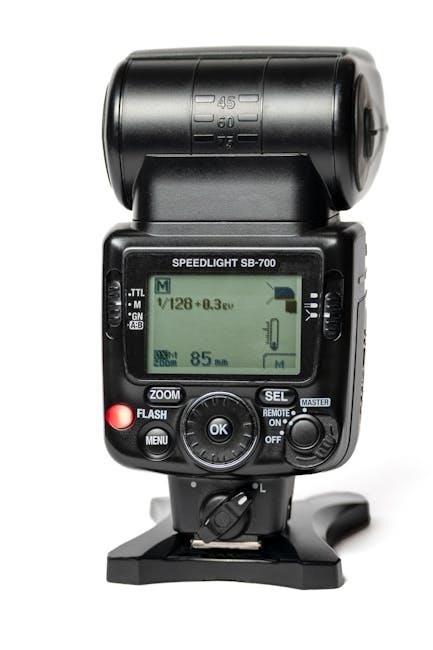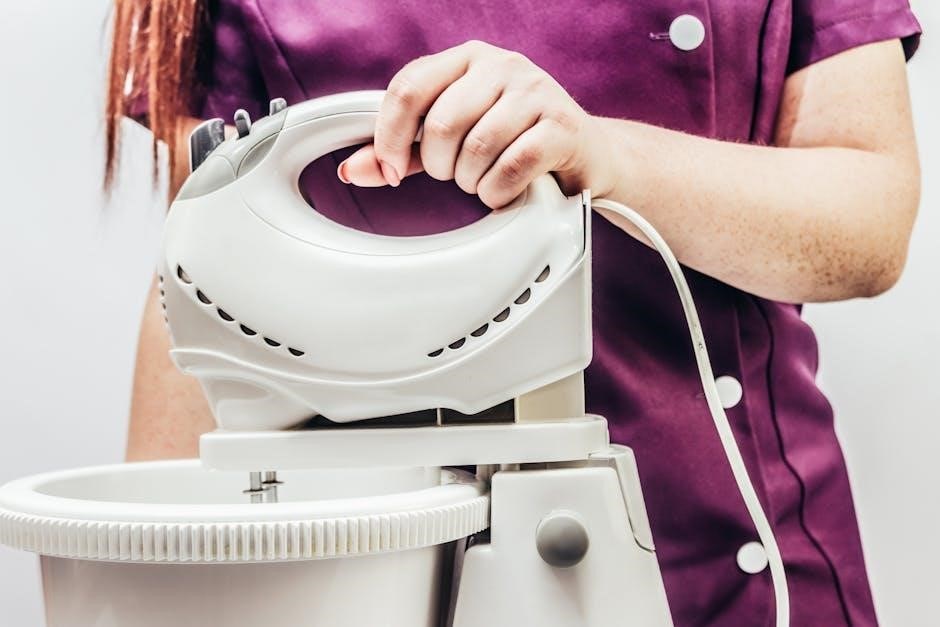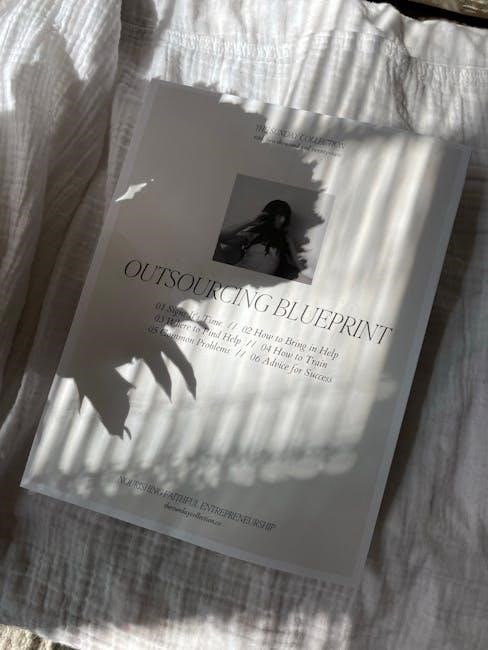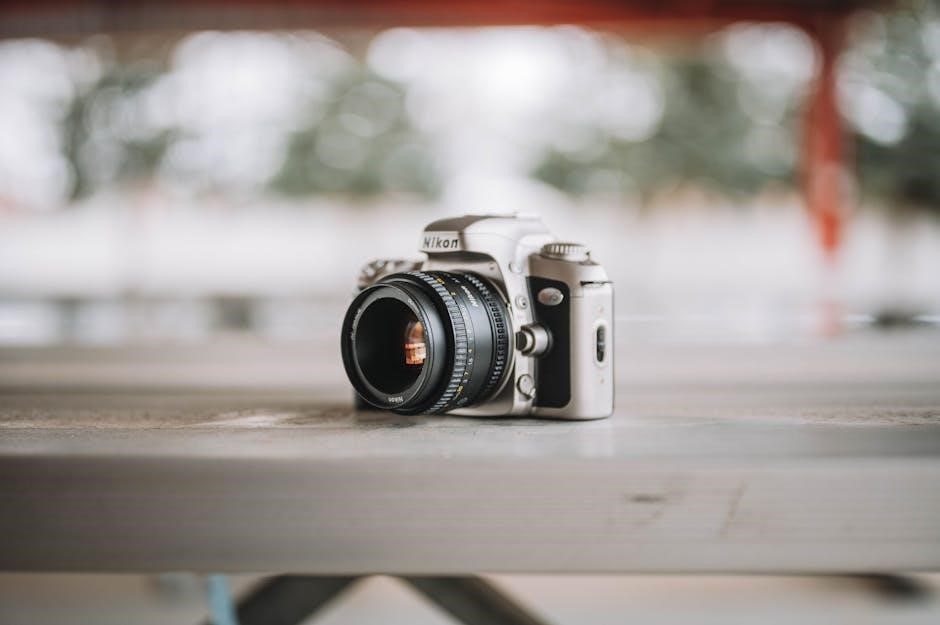The Nikon D60 is a versatile 10.2-megapixel DSLR camera designed for both beginners and enthusiasts. It features an APS-C sensor and offers excellent image quality. Known for its user-friendly interface, the D60 is a popular choice for photographers seeking creative control. This guide provides a comprehensive overview of the camera’s features, settings, and best practices to help you master your Nikon D60.
Overview of the Nikon D60 Camera
The Nikon D60 is a 10.2-megapixel digital single-lens reflex (DSLR) camera designed for photography enthusiasts and beginners. It features an APS-C sensor, offering excellent image quality and color accuracy. Lightweight and ergonomic, the D60 is easy to handle, making it ideal for everyday use. With a variety of shooting modes and manual controls, it provides flexibility for creative photography. This camera is widely praised for its affordability, ease of use, and robust performance, making it a popular choice among photographers looking to elevate their skills. This guide will help you navigate its features and settings effectively.
Importance of the Instruction Manual
The instruction manual is an essential resource for mastering the Nikon D60. It provides detailed explanations of the camera’s features, settings, and functions, ensuring users can fully utilize its capabilities. The manual helps photographers understand how to operate the camera effectively, troubleshoot common issues, and optimize settings for various shooting conditions. By following the guidelines in the manual, users can enhance their photography skills and make the most of their Nikon D60 experience. It serves as a comprehensive reference guide, enabling photographers to unlock the camera’s full potential and achieve professional-quality results.
Safety Precautions
Always handle the camera with care to avoid damage. Keep it away from extreme temperatures and moisture. Use only compatible accessories to ensure safe operation and longevity.
General Safety Guidelines
Always handle the Nikon D60 with care to avoid damage or injury. Keep the camera away from water, extreme temperatures, and direct sunlight. Avoid touching electrical components to prevent static discharge. Use only genuine Nikon accessories to ensure compatibility and safety. Never attempt to disassemble the camera or modify its internal components. Store the camera in a dry, cool place when not in use. Follow proper battery handling guidelines to prevent leaks or explosions. Clean the camera and lenses with soft, dry cloths to avoid scratching. For detailed safety precautions, refer to the provided user manual.
Handling the Camera and Accessories
Handle the Nikon D60 and its accessories with care to ensure longevity. Use genuine Nikon parts to maintain functionality and safety. Avoid exposing the camera to extreme temperatures or moisture. When cleaning, use soft, dry cloths to prevent scratching. Never apply chemicals or abrasive materials to the lens or camera body. For lenses, use a microfiber cloth and avoid touching the glass surface. Store accessories in protective cases to prevent damage. Always refer to the user manual for specific guidance on handling and maintenance to preserve your equipment’s performance and extend its lifespan.

Unboxing and First Impressions
Unboxing the Nikon D60 reveals a compact, lightweight DSLR with a sturdy build. The camera feels ergonomic, fitting comfortably in the hand. Initial impressions highlight its intuitive design, making it accessible for photographers of all skill levels. The included accessories provide everything needed to start shooting immediately, fostering excitement for capturing high-quality images right away.
What’s Included in the Box
Inside the box, you’ll find the Nikon D60 camera body, a rechargeable lithium-ion battery, and a battery charger. Additionally, a neck strap is included for convenient carrying. A USB cable allows for easy connection to your computer, while the Eyepiece Cap protects the viewfinder when not in use. The package also includes a Quick Start Guide to help you get familiar with the camera’s basic functions. For detailed instructions, the comprehensive Users Manual is provided, either in print or as a downloadable PDF. These accessories ensure you’re ready to start capturing stunning photos right away.
Initial Setup and Battery Installation
Start by inserting the provided rechargeable lithium-ion battery into the camera’s battery compartment, ensuring it’s properly aligned and secured. Next, charge the battery using the included charger until the indicator shows a full charge. Once charged, turn on the camera to complete the initial setup. Follow the on-screen prompts to set the language, date, and time. Refer to the Quick Start Guide for a step-by-step walkthrough. For troubleshooting or detailed instructions, consult the Users Manual. Properly charging and installing the battery ensures your Nikon D60 is ready for use, delivering reliable performance right from the start.

Key Features of the Nikon D60
The Nikon D60 features a 10.2-megapixel APS-C sensor, delivering sharp images with vibrant colors. It includes an 11-point autofocus system for precise subject tracking and offers ISO sensitivity up to 3200 for low-light photography. The camera also supports continuous shooting at 3 frames per second and includes built-in image editing tools for quick adjustments. Its compact and lightweight design makes it ideal for everyday use, while the intuitive controls ensure a seamless shooting experience for photographers of all skill levels.
Camera Specifications and Capabilities
The Nikon D60 boasts a 10.2-megapixel CCD sensor, capturing detailed images with 12-bit analog-to-digital conversion. It supports ISO 100-3200 sensitivity, enabling shooting in diverse lighting conditions; The camera features an 11-point autofocus system with 3D tracking for precise subject capturing. It shoots continuous bursts at 3 fps and records NEF (RAW) files for advanced post-processing. The D60 also includes in-camera image editing tools, such as Quick Retouch and Filter Effects, allowing users to enhance photos without a computer.
Unique Selling Points of the D60
The Nikon D60 stands out for its user-friendly interface, making it ideal for beginners while offering advanced features. Its in-camera image editing tools, such as Quick Retouch and Filter Effects, allow for instant enhancements. The D60 supports NEF (RAW) format, enabling professional-grade post-processing. Its 3D tracking autofocus ensures sharp images of moving subjects. Additionally, the camera’s affordable price point and lightweight design make it a great entry-point for DSLR photography without compromising on performance.

Camera Controls and Ergonomics
The Nikon D60 is designed for intuitive operation, featuring a mode dial, ISO and white balance buttons, and a multi-selector for easy navigation. Its ergonomic grip ensures comfortable handling during extended shoots.
Understanding the Camera Layout
The Nikon D60 features an intuitive design with controls strategically placed for easy access. The mode dial on top allows quick switching between shooting modes, while the ISO and white balance buttons are conveniently located for rapid adjustments. The multi-selector on the rear enables efficient menu navigation and focus point selection. The viewfinder provides a clear view of the scene, and the LCD screen displays essential settings and images. The layout is designed to enhance usability, ensuring that photographers can concentrate on capturing moments seamlessly;
Customizing Controls for Comfort
The Nikon D60 allows for customization to suit your shooting style. Assign functions to buttons like the AE-L/AF-L button for quick access to settings like AF-On or Flash Compensation. The multi-selector can be adjusted for vertical or horizontal scrolling in menus. For personal comfort, adjust the diopter on the viewfinder to match your eyesight. Additionally, customize the Shooting Menu to display frequently used settings. These tweaks ensure the camera feels tailored to your preferences, enhancing both comfort and efficiency during use. This level of customization makes the D60 adaptable for photographers of all skill levels.

Setting Up the Camera
Configure your Nikon D60 by setting the date, time, and language in the setup menu. Ensure the camera is updated with the latest firmware for optimal performance. Format the memory card and charge the battery fully before first use. Familiarize yourself with the camera’s layout and customize settings to match your preferences for a seamless shooting experience.
Initial Configuration and Settings
When setting up your Nikon D60 for the first time, begin by configuring the date, time, and language in the setup menu. This ensures your images are timestamped correctly. Next, navigate to the firmware version to check for any available updates, as the latest firmware enhances performance and functionality. It’s also crucial to format the memory card to prepare it for use, ensuring there’s no leftover data. Charge the battery fully before initial use to avoid interruptions. Additionally, review and customize basic settings like image quality and white balance to suit your preferences. Finally, familiarize yourself with the camera’s controls to streamline your workflow.
Updating Firmware and Software
To ensure optimal performance, regularly update your Nikon D60’s firmware and software. Visit Nikon’s official website to download the latest versions. Before updating, connect your camera to a computer using the provided USB cable and install Nikon’s software. Follow the on-screen instructions carefully to avoid interruptions, as this could damage the camera. Ensure the battery is fully charged or use an AC adapter to prevent power loss during the update. After completion, restart the camera to apply the changes. Always verify compatibility and follow Nikon’s guidelines to maintain your camera’s functionality and performance. This step is crucial for accessing new features and bug fixes.
Understanding the Menu System
The Nikon D60’s menu system is intuitive, offering easy access to settings. The Shooting Menu controls image capture, while the Setup Menu manages camera configurations. The Playback Menu handles image review and editing. Customize options like My Menu for quick access to frequently used settings. Navigate using the multi-selector and OK button for seamless adjustments. Refer to the manual for detailed guidance on optimizing the menu system for your photography needs.
Navigating the Shooting Menu
The Shooting Menu on the Nikon D60 allows you to adjust settings for capturing images. Key options include Image Quality, White Balance, and ISO Sensitivity. Use the multi-selector to scroll through choices and press OK to select. Customize settings like Autofocus Mode and Metering Mode for precise control. The menu also offers options for Bracketing and Flash Compensation, enabling advanced techniques. For quick access, add frequently used settings to My Menu. Refer to the manual for detailed explanations of each option to optimize your shooting experience and achieve desired results in various photography scenarios.
Customizing the Setup Menu
The Setup Menu on the Nikon D60 allows you to tailor camera settings to your preferences. Options include Image Review, which controls how images are displayed after shooting, and Auto Info Display, which toggles on-screen shooting information. You can also customize Language, Time Zone, and Date Format for convenience. Use the multi-selector to navigate and press OK to select options. Adjusting these settings enhances your shooting experience by streamlining the interface and minimizing distractions. Refer to the manual for detailed guidance on personalizing the Setup Menu to suit your workflow and preferences.
Utilizing the Playback Menu
The Playback Menu on the Nikon D60 allows you to review and manage your images efficiently. Key features include Delete to remove unwanted photos, Protect to prevent accidental deletion, and Slide Show for presenting images. You can also Rotate pictures shot in portrait orientation and Zoom in on details. Customize the display with options like Hide Image and Indicator, or use Print Set to mark images for printing. These tools simplify photo management and enhance your post-shooting experience. Use the multi-selector to navigate and adjust settings as needed for optimal playback functionality.
Shooting Modes Explained
The Nikon D60 offers various shooting modes, including Auto Mode for simplicity, Manual Mode for advanced control, and Scene Modes for specific photography situations and conditions.
Auto Mode for Beginners
Auto Mode simplifies photography by automatically adjusting settings like exposure, focus, and ISO. Ideal for beginners, it allows you to capture high-quality images without manual adjustments. The camera handles everything, ensuring sharp and well-exposed photos in various lighting conditions. This mode is perfect for learning the basics before transitioning to more advanced settings. For those new to DSLRs, Auto Mode provides a stress-free way to start shooting while understanding how the camera operates. It’s a great starting point for mastering the Nikon D60’s capabilities.
Manual Mode for Advanced Users
Manual Mode offers full creative control over camera settings, allowing advanced users to adjust aperture, shutter speed, and ISO independently. This mode is ideal for photographers who want precise control in challenging lighting conditions. By manually setting these parameters, you can achieve unique effects and ensure optimal image quality. However, it requires a good understanding of photography fundamentals. For experienced users, Manual Mode provides the flexibility to tailor settings to their artistic vision, making it a powerful tool for professional-grade photography with the Nikon D60.
Scene Modes for Specific Situations
The Nikon D60 offers Scene Modes designed for specific photography scenarios, ensuring optimal results in various conditions. Modes like Portrait, Landscape, Child, Sport, and Night Portrait automatically adjust settings for ideal outcomes. For instance, Portrait Mode softens backgrounds, while Landscape Mode enhances sharpness and colors. These modes simplify photography by tailoring camera settings to the situation, making it easier to capture stunning images without manual adjustments. They are perfect for beginners or those who want to focus on composition and creativity, offering a balance between convenience and quality.

Image Quality and Settings
The Nikon D60 offers high-quality image capture with adjustable resolution and compression settings. Customize parameters like white balance and ISO to achieve optimal results in various lighting conditions.
Adjusting Image Resolution and Quality
The Nikon D60 allows users to adjust image resolution and quality settings to suit their needs. Choose from three image sizes: Large (3872×2592 pixels), Medium (2896×1944 pixels), and Small (1936×1296 pixels). Additionally, select from three compression levels: Fine, Normal, and Basic. Higher compression reduces file size but may compromise image detail. For optimal quality, use the Fine setting. These adjustments can be made via the Shooting Menu, ensuring you capture images with the desired balance of quality and file size. Properly setting these parameters is essential for achieving the best results in your photography.
Understanding White Balance Settings
White balance ensures accurate color representation by adjusting to lighting conditions. The Nikon D60 offers Auto, Daylight, Fluorescent, Incandescent, Cloudy, and Shade presets. Each mode compensates for color casts, such as the yellow tint of indoor lighting or the blue tone of shade. For precise control, use the Custom White Balance option by capturing a reference object. Access these settings via the Shooting Menu. Proper white balance enhances image quality and ensures natural colors, making it a crucial step for professional-looking photos. Experiment with different settings to achieve the desired aesthetic in various lighting scenarios.
Focusing and Metering Modes
The Nikon D60 offers Autofocus (AF) and Manual Focus options, plus Single Servo and Continuous Servo modes for dynamic subjects. Metering modes include Matrix, Center-Weighted, and Spot, ensuring precise exposure control for sharp, well-balanced images.
Autofocus Modes and Techniques
The Nikon D60 features three primary Autofocus (AF) modes: Single Servo AF for stationary subjects, Continuous Servo AF for moving subjects, and Manual Focus for precise control. Utilize the AF-Area Mode to select from Closest Subject Priority, Dynamic Area AF, or Single Area AF. To enhance focus accuracy, employ techniques like using the center focus point for initial focus and recomposing. Additionally, adjust the AF sensitivity and focus tracking settings to optimize performance for your shooting scenario. Regularly clean the lens and sensor to maintain sharp images.
Manual Focus for Precision
For situations requiring utmost control, the Nikon D60 allows Manual Focus operation. Engage manual focus via the lens focus ring or by pressing the MF button. Use the viewfinder’s focusing screen for precise adjustments. This mode is ideal for low-light conditions or when autofocus struggles. Techniques include focusing on high-contrast areas and using the camera’s magnified view for accuracy. Regularly clean the lens and sensor to ensure sharp images. Manual focus is particularly useful for macro, portrait, or still-life photography, offering creative control over your shots. Mastering this feature enhances your ability to capture detailed, professional-quality images. Always ensure the lens is clean to maintain optimal performance.
Understanding Metering Modes
The Nikon D60 offers three metering modes to ensure accurate exposure: Matrix Metering, Center-Weighted Metering, and Spot Metering. Matrix Metering analyzes the entire scene for balanced exposure. Center-Weighted Metering prioritizes the central area, ideal for portraits. Spot Metering measures a small section, perfect for high-contrast situations. The D60 also links metering to autofocus points, ensuring precise exposure for your subject. Adjustments can be made using exposure compensation. Understanding these modes allows you to control lighting effectively, enhancing your photography. Regular practice helps master their application in various scenarios, ensuring optimal results.

Using the Built-In Flash
The Nikon D60’s built-in flash is compact and convenient for everyday use. It automatically activates in low-light conditions, providing balanced illumination for your subjects. Use it wisely to enhance your photos without harsh shadows.
Flash Modes and When to Use Them
The Nikon D60 offers multiple flash modes to suit various shooting scenarios. Auto Flash automatically activates in low-light conditions, while Forced Flash ensures the flash fires regardless of lighting. Slow Sync Flash combines flash with ambient light for creative effects, ideal for night portraits. Red-eye Reduction minimizes red-eye in portraits by emitting a pre-flash. Each mode is easily selectable via the camera menu, allowing you to adapt to different situations and achieve professional-looking results. Understanding these modes enhances your ability to capture well-lit, natural-looking images in any setting.
Adjusting Flash Compensation
Flash compensation on the Nikon D60 allows you to fine-tune the flash output for balanced lighting. Use the Flash Compensation button to adjust the intensity in increments of +/-3 EV. This is ideal for correcting overexposed or underexposed subjects. For example, reduce flash power in bright conditions or increase it in low-light scenarios. Access this feature via the Shooting Menu or by pressing the Flash Compensation button and rotating the command dial. This ensures your images have natural lighting and avoids harsh shadows or blown-out highlights. Adjustments are reflected in real-time on the LCD screen for precise control.

External Accessories and Lenses
The Nikon D60 supports a wide range of external accessories and lenses, enhancing its versatility. Compatible with Nikon’s F-mount system, it offers options like standard zoom, prime, and telephoto lenses. Additional accessories include external flashes, remote shutters, and memory cards, while cases and bags provide protection. Third-party lenses from brands like Sigma and Tamron are also available, ensuring users can customize their setup for various photography needs and preferences.
Compatible Lenses for the D60
The Nikon D60 is compatible with a wide range of high-quality lenses, including AF-S Nikkor, DX, and telephoto lenses. Designed for versatility, the D60 supports lenses with Nikon’s F-mount system, ensuring sharp images and precise focus. Popular options include the AF-S DX NIKKOR 18-55mm and 55-200mm lenses, ideal for everyday photography. Telephoto lenses like the AF-S DX NIKKOR 55-300mm extend reach, while wide-angle lenses capture broader perspectives. Additionally, third-party lenses from brands like Sigma and Tamron offer affordable alternatives without compromising quality, making the D60 adaptable to various shooting styles and creative needs.
Using External Flashes and Accessories
The Nikon D60 supports external flashes and accessories to enhance functionality. External flashes like the SB-400 and SB-600 provide better lighting control, especially in low-light conditions. These flashes offer features like bounce and swivel heads for versatile lighting options. Additionally, remote controls and wireless triggers enable off-camera flash use, expanding creative possibilities. Tripods and monopods are also compatible, aiding in stabilization for sharp images. Other accessories, such as camera grips and protective cases, enhance ergonomics and safeguard the device. Always refer to the manual for compatibility and proper usage guidelines to maximize performance and results.

Tips for Better Photography
Mastering the Nikon D60 begins with understanding its features and practicing composition. Use the rule of thirds, experiment with lighting, and adjust settings to capture stunning images consistently.
Composition and Lighting Tips
For compelling photos, use the rule of thirds and lead lines to guide the viewer’s eye. Natural light enhances images; shoot during the golden hour for soft, warm tones. Avoid harsh midday sun by using shade or diffusers. Experiment with backlight for silhouettes or rim lighting. Pay attention to shadows to add depth and dimension. Adjust white balance settings to match lighting conditions. Use reflectors or flash to fill shadows. Keep the background simple to focus attention on your subject. Practice experimenting with different lighting setups to achieve desired effects and elevate your photography.
Optimizing Camera Settings for Results
For standout images, adjust the ISO to minimize noise in low light. Use white balance presets or custom settings to ensure accurate colors. Experiment with metering modes like matrix, center-weighted, or spot to control exposure. Leverage autofocus modes such as AF-C for moving subjects or AF-S for stationary ones. Fine-tune contrast and saturation for vibrant results. Shoot in RAW format for maximum post-processing flexibility. Regularly review your photos to refine settings. Practice with different configurations to master the Nikon D60’s capabilities and achieve professional-quality images consistently.

Maintenance and Troubleshooting
Regularly clean the sensor and lens to prevent dust and smudges. Update firmware for optimal performance. Refer to the manual for troubleshooting common issues like error messages or connectivity problems.
Cleaning and Maintaining the Camera
Regular maintenance ensures optimal performance. Use a soft, dry cloth to clean the camera body and lens. For the sensor, use a blower or cleaning brush to remove dust. Avoid harsh chemicals or abrasive materials. Clean the lens with a microfiber cloth and lens cleaning solution. Store the camera in a cool, dry place to prevent moisture damage. Update firmware regularly to maintain functionality. Refer to the manual for detailed cleaning instructions and troubleshooting tips to extend the camera’s lifespan and ensure peak performance.
Common Issues and Solutions
Common issues with the Nikon D60 include blurry images, battery drain, and sensor dust. For blurry photos, ensure autofocus is enabled and Image Stabilization is activated. Battery life can be extended by turning off unnecessary features like the LCD preview. Sensor dust can be removed using a cleaning brush or blower. If error messages appear, restart the camera or update firmware. For memory card errors, format the card in-camera. Refer to the manual for troubleshooting guides and solutions to resolve these issues effectively and maintain optimal camera performance. Always use genuine Nikon accessories to avoid compatibility problems.
The Nikon D60 is a powerful tool for capturing stunning images. For further learning, visit Nikon’s official website for detailed manuals, firmware updates, and photography guides. Explore community forums and support pages for troubleshooting and advanced techniques to enhance your photography journey with the D60. Happy shooting!
Final Thoughts on the Nikon D60
The Nikon D60 remains a reliable and user-friendly DSLR, offering excellent image quality and intuitive controls. Its compact design and robust feature set make it ideal for photographers of all levels. While newer models have surpassed it, the D60 still delivers impressive results. Regularly updating firmware and exploring additional resources like Nikon’s official website and community forums can further enhance your experience. With proper care and maintenance, the D60 continues to be a trusted companion for capturing memorable moments. Happy shooting with your Nikon D60!
Additional Resources for Learning
For deeper understanding, visit Nikon’s official website for downloadable manuals and firmware updates. Explore Nikon’s support page for tutorials, troubleshooting guides, and software downloads. Join Nikon community forums and groups to connect with experts and enthusiasts. Check out Nikon-authorized training centers for workshops and online courses. Utilize Nikon’s YouTube channel for video tutorials and tips. These resources help you master the D60 and stay updated on the latest techniques and camera care. Enhance your photography journey with these valuable learning tools and community support.



